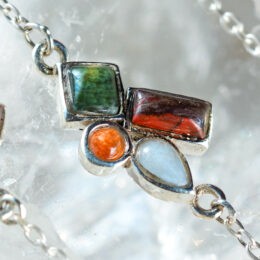Smithsonite Guide: Properties and Meaning

Smithsonite Properties
Color: Blue, PinkMohs Hardness: 4Chakra: Heart ChakraCrystal Structure:TrigonalLocation: New Mexico, Arizona, France
About Smithsonite
Smithsonite is a healing stone associated with the throat and heart chakras. It commonly appears in shades of blue and pink. This stone has detoxifying properties that release negative energy and promote transformation and transmutation. Smithsonite also supports the immune system and relieves pain, making it a versatile tool for healing the body, mind, and spirit. Whether you aim to release addiction or promote overall wellness, Smithsonite is a valuable addition to any healing practice.
The history of Smithsonite
Smithsonite has a long history dating back to ancient times. It was named after James Smithson, an English scientist and mineralogist who discovered the stone in the late 18th century. However, the use of Smithsonite in healing practices can be traced back even further. Ancient civilizations, such as the Egyptians and the Native Americans, recognized the powerful properties of this gemstone. They utilized it for spiritual rituals, protection, and promoting overall well-being. Today, Smithsonite continues to be highly regarded for its healing properties and is cherished by crystal enthusiasts and practitioners alike.
What are the healing properties of Smithsonite?
Smithsonite is a powerful healing stone associated with the throat and heart chakras. It has detoxifying properties that release negative energy and promote transformation and transmutation. Smithsonite supports the immune system and relieves pain, making it a versatile tool for healing the body, mind, and spirit.
What are the metaphysical/spiritual properties of Smithsonite?
Smithsonite is associated with the throat and heart chakras, benefiting communication, emotional healing, and love. It enhances intuition and psychic abilities. Smithsonite promotes overall wellness and balance in the mind, body, and spirit.
Smithsonite FAQ
What is Smithsonite used for?
Smithsonite is commonly used as a gemstone in jewelry due to its beautiful colors and patterns. It is also used in the production of zinc as a major ore of this metal. Additionally, Smithsonite is used in the manufacturing of ceramics, glass, and pigments.
What does Smithsonite do?
Smithsonite has various metaphysical properties. It promotes emotional healing and balance, helping individuals overcome grief, trauma, and stress. Smithsonite enhances communication skills and stimulates creativity. It brings a sense of calmness and tranquility to the wearer.
Can Smithsonite go in water?
Smithsonite is generally safe to be submerged in water. However, prolonged exposure to water may cause damage to the gemstone, especially if it contains any metal components. It is recommended to consult with a professional jeweler or gemologist before immersing Smithsonite in water.
How to cleanse Smithsonite?
To cleanse Smithsonite, you can rinse the gemstone under lukewarm running water while visualizing any negative energies being washed away. Another method is to place Smithsonite in a bowl of water mixed with sea salt or use a soft brush to gently cleanse the gemstone. Avoid using harsh chemicals or abrasive materials that may damage the stone.
What does Smithsonite do spiritually?
Smithsonite has spiritual properties that enhance one’s spiritual journey. It promotes self-discovery, intuition, and spiritual growth. Smithsonite facilitates communication with higher realms and enhances psychic abilities. It is often used by individuals seeking to deepen their spiritual connection and expand their consciousness.
How to clean Smithsonite?
To clean Smithsonite, you can use a soft cloth or a soft brush with mild soap and lukewarm water. Gently scrub the gemstone to remove any dirt or debris. Avoid using harsh chemicals or ultrasonic cleaners, as they may damage the stone. After cleaning, rinse the Smithsonite thoroughly and pat it dry with a soft cloth.
How to spot fake Smithsonite?
To spot fake Smithsonite, look for a natural and unique pattern of colors and markings. Genuine Smithsonite will not appear too perfect or uniform in color. It will have a moderate hardness and will not easily scratch or chip. Purchase gemstones from reputable sources to ensure authenticity.
Is Smithsonite toxic?
Smithsonite is generally considered non-toxic. However, handle any gemstone with care and avoid ingesting or inhaling any particles. If you have concerns about the safety of Smithsonite, consult with a professional gemologist or healthcare provider.
Where is Smithsonite found?
Smithsonite is found in various locations around the world, including the United States, Mexico, Namibia, Australia, and China. The specific locations where Smithsonite is found can vary, but it is often associated with zinc ore deposits.
How is Smithsonite pronounced?
Smithsonite is pronounced as “smith-son-ite.” The emphasis is on the second syllable, “son.”
What chakra is associated with Smithsonite?
Smithsonite is associated with the Heart chakra. It opens and activates the Heart chakra, promoting love, compassion, and emotional healing. Smithsonite helps individuals connect with their emotions and foster harmonious relationships.
Can Smithsonite be in the sun?
Smithsonite can be safely exposed to sunlight. However, prolonged exposure to direct sunlight may cause the color of the gemstone to fade over time. It is recommended to store Smithsonite in a cool and dark place when not in use to preserve its color and quality.
How to charge Smithsonite?
To charge Smithsonite, place it in direct sunlight or moonlight for a few hours. The energy from the sun or moon will help recharge and revitalize the gemstone. Alternatively, bury Smithsonite in the earth for a period of time to allow it to absorb the earth’s natural energy.
What is the hardness of Smithsonite?
Smithsonite has a hardness of 4 to 4.5 on the Mohs scale. This means that it is relatively soft and can be easily scratched by harder materials. Handle Smithsonite with care and avoid exposing it to rough surfaces or abrasive materials that may cause damage.
















